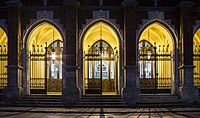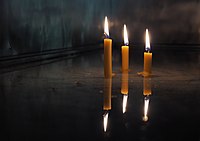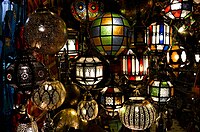Flare
This article needs additional citations for verification. (November 2014) |


A flare, also sometimes called a fusée, fusee, or bengala,[1][2] bengalo[3] in several European countries, is a type of pyrotechnic that produces a bright light or intense heat without an explosion. Flares are used for distress signaling, illumination, or defensive countermeasures in civilian and military applications. Flares may be ground pyrotechnics, projectile pyrotechnics, or parachute-suspended to provide maximum illumination time over a large area. Projectile pyrotechnics may be dropped from aircraft, fired from rocket or artillery, or deployed by flare guns or handheld percussive tubes.
Origin[edit]
The earliest recorded use of gunpowder for signaling purposes was the 'signal bomb' used by the Chinese Song Dynasty (960–1279) as the Mongol-led Yuan Dynasty (1271–1368) besieged Yangzhou in 1276.[4] These soft-shelled bombs, timed to explode in midair, were used to send messages to a detachment of troops far in the distance. Another mention of the signal bomb appears in a text dating from 1293 requesting their collection from those still stored in Zhejiang.[4] A signal gun appears in Korea by 1600. The Wu I Thu Phu Thung Chih or Illustrated Military Encyclopedia, written in 1791, depicts a signal gun in an illustration.[5]
Civilian use[edit]

In the civilian world, flares are commonly used as signals, and may be ignited on the ground, fired as an aerial signal from a pistol-like flare gun, or launched from a self-contained tube. Flares are commonly found in marine survival kits.
Maritime distress signal[edit]
Distress rockets (aka "rocket-propelled parachute flares"[6]) have been mentioned in the modern era for civilian maritime emergencies since at least 1856. The U.S. Nautical Magazine of that year mentions the use of "rocket stations" for ship related emergencies.[7] White rockets were solely used until 1873, when commander John Yorke of the Royal Navy suggested that rockets for distress should have a distinctive color. The request was made to help ease confusion between ships in distress and rockets used by pilot ships.[8] By 1875, the Board of Trade (UK) had issued regulations for Captains in regards to night signals. Rockets containing at least 16oz of composition were only to be used as a sign for a ship in distress. Passenger ships at the time were required to carry 12 of these rockets.[9] The Merchant Shipping Act of 1894 further stated that these rockets were to be fired one at a time in short intervals of approximately one minute apart.[10] Distress rockets continued to be used in different colors as was the case with RMS Titanic. At the time shipping companies had "a particular kind of distress rocket (that differed by color)". Each ship was also given a guide of colors to use depending on what signal was to be sent.[10][11]
Modern red distress signals are mentioned by the United States Bureau of Mines as early as 1925, where they state "12 handheld rocket-propelled parachute red flare distress signals" are to be used by ocean going ships.[12] The color red was eventually incorporated for use in the United States on December 17, 1979 as part of a "Universal color language".[6] Red distress rockets and/or flares are now internationally recognized symbols that indicate a ship in distress.[13][14] The International Convention for the Safety of Life at Sea (SOLAS) has standards for visual signals, including both handheld and aerial flares. Handheld flares must burn for at least one minute at an average luminosity of 15,000 candelas, while aerial flares must burn for at least 40 seconds with a 30,000-candela average luminosity.[15]
While rockets and flares are still an option for signaling distress, they have since been surpassed by improved technology. Distress signals can now be sent using automated radio signals from a search and rescue transponder. Other internationally recognized methods include the radio message SOS, which was used during the Sinking of the Titanic, and/or the emergency procedure word "MAYDAY" which dates to the 1920s.[13][16][17]
Roadside & Rail[edit]

Another type of flare is the fusee, which burns with a bright red light.[18] These come in two main types which are used for roadways and rail transportation. The first type are fusees used for roadways which are known as highway flares or road flares.[19][20] These are commonly used to indicate obstacles or advise caution on roadways at night and are found in roadside emergency kits.[21] Law enforcement also may use these flares (either propped on a biped or laid flat) to signal traffic hazards or that a road is blocked, often as a more visible replacement for traffic cones.[22][23][24] Law enforcement in the United States usually use magnesium-based flares that last from 15–30 minutes.[24]
Fusees used for rail are known as railroad flares, they are commonly used to perform hand signals or used as torches in rail transport applications.[18][25] Railroad flares can burn for at least 10 minutes, are not fastened to train cars, and are handheld by railroad personnel for protection at night.[18] It was argued during an Appeals case that railroad flares are much more visible than lanterns.[18] In general: trains that encounter a lit railroad flare are required to stop until it burns out.[26] Fusees made specifically for railroad use can be distinguished from highway fusees by a sharp steel spike at one end, used to embed the fusee upright in a wooden railroad tie.
Forestry & firefighting[edit]
In forestry and firefighting, fusees are sometimes used in wildfire suppression and in the ignition of controlled burns. They ignite at 191 °C (376 °F) and burn as hot as 1,600 °C (2,910 °F).[27] They are especially effective[according to whom?] in igniting burnouts or backburns in very dry conditions, but not so effective when fuel conditions are moist.[citation needed] Since controlled burns are often done during relatively high humidity levels (on the grounds that they could not be safely contained during periods of very low humidity), the driptorch is more effective[according to whom?] and more often used.[citation needed] Fusees are also commonly carried by wildland firefighters for emergency use, to ignite an escape fire in surrounding fuels in case of being overrun by a fire if no other escape routes are available.[citation needed]
Protests[edit]
Flares are used by law enforcement agencies such as the United States National Guard, and police as a form of riot control. This practice dates back to at least the 1940s where they are mentioned as being "useful in night operations".[28] Handheld flares are also counter used by protestors at demonstrations.[29]
Military use[edit]
Maritime signal flare[edit]
In 1859, Martha Coston patented the Coston flare based on early work by her deceased husband Benjamin Franklin Coston.[30] It was used extensively by the US Navy during the Civil War and by the United States Life-Saving Service (the precursor to the US Coast Guard) to signal to other ships and to shore. Calcium phosphide is often used in naval flares, as in contact with water it liberates phosphine which self ignites in contact with air; it is often used together with calcium carbide which releases acetylene.[citation needed]
Illumination[edit]
In 1922, a "landing flare" was an aerial candle attached to a parachute and used for landing an airplane in the dark. The flare burned for less than four minutes and the candlepower was about 40,000 lumens.[31]
Countermeasure[edit]
A special variety of flares is used in military aircraft as a defensive countermeasure against heat-seeking missiles. These flares are usually discharged individually or in salvos by the pilot or automatically by tail-warning devices, and are accompanied by vigorous evasive maneuvering. Since they are intended to deceive infrared missiles, these flares burn at temperatures of thousands of degrees, incandescing in the visible spectrum as well.
Tripflares[edit]
Flares connected to tripwires are used to guard an area against infiltration. The flare begins burning when the tripwire is triggered, providing both alarm and illumination.
Regulation[edit]
Under the UN hazard number system, pyrotechnic flares are designated class 1.4 explosives.[32]
Several U.S. states, including California and Massachusetts, have begun regulating levels of potassium perchlorate, which can be unsafe at certain levels in drinking water. Contaminated drinking water can lead to such symptoms as gastric irritation, nausea, vomiting, fever, skin rashes, and even fatal aplastic anemia (a reduction in all types of blood cells).[33]
Chemistry[edit]
Flares produce their light through the combustion of a pyrotechnic composition. The ingredients are varied, but often based on strontium nitrate, potassium nitrate, or potassium perchlorate, mixed with a fuel such as charcoal, sulfur, sawdust, aluminium, magnesium, or a suitable polymeric resin.[34] Flares may be colored by the inclusion of pyrotechnic colorants. Calcium flares are used underwater to illuminate submerged objects. *Note- Fusees manufactured in the United States no longer use potassium perchlorate as an oxidizer and do not contain aluminium or magnesium.
Perchlorate flare health issues[edit]
Many in-service colored signal flares and spectrally balanced decoy flares contain perchlorate oxidizers. Perchlorate, a type of salt in its solid form, dissolves and moves rapidly in groundwater and surface water. Even in low concentrations in drinking water supplies, perchlorate is known to inhibit the uptake of iodine by the thyroid gland. While there are currently no US federal drinking water standards for perchlorate, some states have established public health goals or action levels, and some are in the process of establishing state maximum contaminant levels. For example, the US Environmental Protection Agency has studied the impacts of perchlorate on the environment as well as drinking water.[35] California has also issued guidance regarding perchlorate use.[36]
US courts have taken action regarding the use of perchlorate in manufacturing pyrotechnic devices such as flares. For example, in 2003, a federal district court in California found that the Comprehensive Environmental Response, Compensation and Liability Act (CERCLA) applied because perchlorate is ignitable and therefore a "characteristic" hazardous waste.[37]
See also[edit]
- Blue light (pyrotechnic signal) – Early pyrotechnic signal
- Flare gun – Firearm that launches flares
- Magnesium torch – Bright light source made from magnesium, which burns underwater
- Shell (projectile) – Payload-carrying projectile
References[edit]
- ^ "Fumogeni e bengala allo stadio: Quando è reato?". 27 March 2018.
- ^ "Un niño herido por la pirotecnia de los ultras del Sporting de Portugal". 24 February 2023.
- ^ "Freimann: England-Fan zündet Bengalo in seinem Hotelzimmer". 7 June 2022.
- ^ a b Needham, Joseph (1986). Science and Civilisation in China: The Gunpowder Epic. Cambridge University Press. p. 169. ISBN 978-0-521-30358-3.
- ^ Needham, Joseph (1986). Science and Civilisation in China: The Gunpowder Epic. Cambridge University Press. p. 331. ISBN 978-0-521-30358-3.
- ^ a b Subpart: 160.036 Hand–Held Rocket–Propelled Parachute Red Flare Distress Signals. United States Government Publishing Office. 2010. p. 97. ISBN 9780160840425.
{{cite book}}:|work=ignored (help) - ^ Robert Postans (1856). Night Signals at Sea. Vol. 5. Griffiths & Bates. pp. 125–132.
{{cite book}}:|work=ignored (help) - ^ To the Editor of the Times. Waterlow & Sons. 1873. p. 96.
{{cite book}}:|work=ignored (help) - ^ Rockets for Distress Signals. Cambridge University Press. 1875. pp. 956–957. ISBN 9781108056540.
{{cite book}}:|work=ignored (help) - ^ a b Patricia Leavy (2007). Historical Sketches of the Events. Lexington Books. pp. 44–45. ISBN 9780739115206.
{{cite book}}:|work=ignored (help) - ^ United States Hydrographic Office (1917). General Remarks. United States Government Publishing Office. p. 47.
{{cite book}}:|work=ignored (help) - ^ Marine Distress Signals. United States Bureau of Mines. 1925. p. 5.
{{cite book}}:|work=ignored (help) - ^ a b David House (2014). Internationally Recognized Distress Signals. Taylor & Francis. p. 197. ISBN 9781317673163.
{{cite book}}:|work=ignored (help) - ^ "The Merchant Shipping (Distress Signals and Prevention of Collisions) Regulations 1996" (PDF). UK Maritime and Coast Guard Agency. 1996. Archived (PDF) from the original on 9 October 2022. Retrieved 23 July 2013.
- ^ "International Life-Saving Appliance (LSA) Code [under the auspices of the International Convention for the Safety of Life at Sea [SOLAS] of 1 November 1974] (London, 4 June 1996) [1998] ATS 31". www.austlii.edu.au. Retrieved 6 March 2022.
- ^ "It's MayDay – But That Means Trouble for Aviators". May 2017. Archived from the original on 24 March 2019. Retrieved 31 March 2018.
- ^ Learmonth, Bob; Nash, Joanna; Cluett, Douglas (1977). The First Croydon Airport 1915–1928. Sutton: London Borough of Sutton Libraries and Arts Services. p. 55. ISBN 978-0-9503224-3-8.
- ^ a b c d Fusee. United States Court of Appeals for the Seventh Circuit. 1951. p. 7.
{{cite book}}:|work=ignored (help) - ^ Highway Flare Signal Device. United States. Small Business Administration. 1964. p. 31.
{{cite book}}:|work=ignored (help) - ^ Zimmer-cross. State of New York. 2009. p. 37.
{{cite book}}:|work=ignored (help) - ^ Automobile Cases. Commerce Clearing House. 1961. p. 801.
- ^ "Emergency Flares For Road & Highway Usage » Traffic Safety Resource Center". Traffic Safety Resource Center. 17 May 2019. Retrieved 15 June 2021.
- ^ "Police Roadside Safety: Tools to Increase Visibility". National Institute of Justice. Retrieved 15 June 2021.
- ^ a b "Evaluation of Chemical and Electric Flares" (PDF). Office of Justice Programs. 12 June 2008. Archived (PDF) from the original on 9 October 2022. Retrieved 16 June 2021.
- ^ Raymond H. Myers, Douglas C. Montgomery, Christine M. Anderson-Cook (2009). Constraints on the Component Proportions. Wiley. p. 603. ISBN 9780470174463.
{{cite book}}:|work=ignored (help)CS1 maint: multiple names: authors list (link) - ^ Statement of Facts. United States Court of Appeals for the Seventh Circuit. 1973. p. 2.
{{cite book}}:|work=ignored (help) - ^ The New Generation Fire Shelter (PDF). National Wildfire Coordinating Group. March 2003. Archived from the original (PDF) on 16 January 2009. Retrieved 16 January 2009.
- ^ Sterling A. Wood (1940). Flares. Military service publishing Company. p. 70.
{{cite book}}:|work=ignored (help) - ^ Pierre Bairin and Hanna Ziady (6 April 2023). "Protesters storm BlackRock's Paris office holding red flares and firing smoke bombs". CNN. Archived from the original on 6 April 2023. Retrieved 11 July 2023.
- ^ Vare, Ethlie Ann; Ptacek, Greg (2002). Patently female : from AZT to TV dinners : stories of women inventors and their breakthrough ideas. New York: Wiley. p. 23. ISBN 0471023345.
- ^ Chisholm, Hugh (1922). The Encyclopædia Britannica: The New Volumes, Constituting, in Combination with the Twenty-nine Volumes of the Eleventh Edition, the Twelfth Edition of that Work, and Also Supplying a New, Distinctive, and Independent Library of Reference Dealing with Events and Developments of the Period 1910 to 1921 Inclusive. Encyclopædia Britannica, Company Limited.
- ^ "History of Flares". SiriusSignal.com. Sirius Signal. Retrieved 8 June 2015.
- ^ Borowicz, Krzysztof; Dion, Megan; Mehta, Jason; Morgan, Glen (18 December 2014). "Disposal of Pyrotechnic Visual Distress Signals" (PDF). United States Coast Guard. Archived (PDF) from the original on 9 October 2022.
- ^ "Mark Spiegl's Road Flare Composition Page". www.spiegl.org. Retrieved 6 March 2022.
- ^ "Water: Unregulated". EPA. Archived from the original on 18 February 2015. Retrieved 5 March 2022.
- ^ "Perchlorate in Drinking Water". Archived from the original on 27 June 2010. Retrieved 24 June 2010.
- ^ Jackson, Jim (March 2010). "Pipeline Flash Reactor Technology Selected for Castaic Lake Water Agency Expansion". Journal - American Water Works Association. 102 (3): 33–34. doi:10.1002/j.1551-8833.2010.tb10070.x. ISSN 0003-150X. S2CID 116522917.
Further reading[edit]
- Wallbank, Alister (2001). "Can anybody see me? (modified reprint from DIVER 2000; 45 (2) February: 72–74)". Journal of the South Pacific Underwater Medicine Society. 31 (2): 116–119. Archived from the original on 16 January 2009. Retrieved 13 October 2008.
{{cite journal}}: CS1 maint: unfit URL (link)
External links[edit]
 Media related to Flares (pyrotechnics) at Wikimedia Commons
Media related to Flares (pyrotechnics) at Wikimedia Commons



